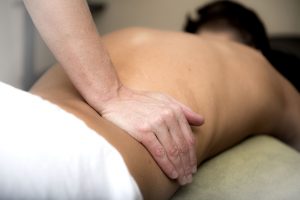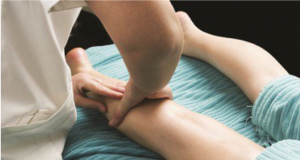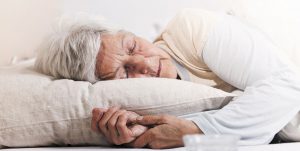What Is the “End Feel”?
Some of the most valuable assessment information is derived from relatively simple procedures such as passive range-of-motion tests. While many massage practitioners have been exposed to the fundamental concepts of active and passive range-of-motion testing, most have not learned how to use this information effectively in a clinical environment.
In this article, we will focus particular attention on the “end feel” that is evaluated during passive range-of-motion testing. Valuable information can be derived from thorough examination of the end feel.
To perform a passive movement evaluation, the practitioner instructs the client to relax as much as possible preceding the movement. It is important to have the greatest degree of muscular relaxation prior to beginning the movement, to improve the accuracy of the evaluation and eliminate muscular effort as the cause of any pain that is felt.
One of the most important factors to investigate with passive range-of-motion testing is the end feel. The end feel is the quality of movement perceived by the practitioner at the very end of the available range of motion. The end feel can reveal a great deal about the nature of various pathologies. James Cyriax, the British orthopedic physician who developed one of the most commonly used systems for physical examination, specified six different end feels when he first described them in his writings.1
Bone to bone – This is the sensation when motion is stopped by two bones contacting one another. An example is the end feel for extension of the elbow.
Muscle spasm – When muscles are in spasm, they may abruptly halt motion prior to what should be the normal range of motion. It is likely that pain will be felt at the end of this range, because the muscle in spasm will be stretched.
Capsular – This is the end feel described for range of motion limited at the end by the joint capsule. The sensation often described is a “leathery” feel to the end of the motion, such as in external rotation of the shoulder. A true capsular end feel occurs when the joint capsule is the primary limitation to the end range of motion. Some authors have called this end feel the “tissue stretch” end feel and extended it to other tissues, such as muscles, that may stretch normally at the end of their range of motion. An example of the tissue stretch with muscles would be hip flexion with the knee held in extension, in which motion is stopped by the hamstrings.
Springy block – This end feel is the sensation of motion stopping short of where it should, accompanied by a rubbery or springy sensation at the end. It occurs most often in joints in which a piece of loose cartilage (like the meniscus in the knee) may be blocking full motion and causing the limbs to “bounce back” a bit.
Tissue approximation – This is the end feel in which motion is stopped by two masses of soft tissue pressing on one another. An example is in flexion of the elbow, in which the elbow flexors and wrist flexors press on each other to limit further motion.
Empty – This end feel has no mechanical limitation to the end of the range, but the client will not let you go any farther because of excessive pain. An example would be in shoulder impingement, in which pain from the supraspinatus tendon being compressed will limit how far the arm can be abducted. Mechanically there is no further restriction, but the pain will prevent the individual from allowing further motion.
The end feel for a particular joint may be the joint’s normal end feel, or it may be pathological in nature. For example, in elbow extension, the normal end feel would be bone to bone as the olecranon process contacts the posterior aspect of the olecranon fossa. If you were performing a passive range-of-motion evaluation with your client and you got a tissue stretch end feel for the elbow in extension, it would most likely indicate some form of restricted range of motion that should be treated.
On the other hand, if you were evaluating medial rotation of the shoulder, you would expect a tissue stretch end feel, and that would be normal for medial rotation. If you performed medial rotation and got a bone- to-bone end feel, it would be abnormal for that joint and would certainly indicate a more serious joint pathology requiring evaluation by another health professional.
Passive range-of-motion evaluation can provide a great deal more information than just how far an individual can move his/her joint. When you know what kind of end feel should be apparent with each joint, you can effectively evaluate and analyze pathological limitations to motion.
Reference
- Cyriax J. Textbook of Orthopaedic Medicine, Volume One: Diagnosis of Soft Tissue Lesions, 8th ed. London: Bailliere Tindall, 1982.
Ready to #feelbetter?
You're just a click away from a wicked good massage!
-

60 Minute Massage Gift Card
$170.00 Add to cart -

90 Minute Massage Gift Card
$255.00 Add to cart -

Mini Aer Small Room Air Purifier
$149.00 Add to cart -
Sale!

Thera-Pearl Sports Pack/Hot Cold
Original price was: $14.99.$12.99Current price is: $12.99. Add to cart -

3 Somadome Sessions Gift Card
$135.00 Add to cart -

20 Minute Somadome Gift Card
$45.00 Add to cart -
Sale!

TheraBand® Stretch Strap
Original price was: $19.99.$14.99Current price is: $14.99. Add to cart -

TheraBand CLX Connective Loop
$14.99 Select options
Energy Boosters
Energy Boosters Ways to Get You Through the Day No amount of coaxing, pleading, or pedal pumping could get the engine in the rental car to turn over. It was going nowhere. The travelers had filled the car with unleaded fuel, but it had a diesel engine. It had been able to run a little…
Read MoreWhat is Qi?
What is Qi? A fundamental concept of traditional Chinese medicine (TCM) dating back over 3,000 years, qi (pronounced “chee”) is the Chinese word for energy, which also carries with it connotations of “air,” “breath,” and “life force.” In TCM, it is understood that everything from humans and animals to rocks and trees is filled with…
Read MoreWhy Buy Organic?
Why Buy Organic? Is the Higher Price Worth It? While shopping in your grocery store’s produce section, you may notice the organically grown apples are pocked and not as big and perfectly round as the conventional produce, but they are more expensive. What’s the difference, and which do you choose? Your decision may significantly impact…
Read MoreAre You Making the Most of Your Massage?
Are You Making the Most of Your Massage? How to Prolong the Benefits of Bodywork A massage works in wonderful ways, easing stress and pain, calming the nervous system, increasing circulation, loosening tight muscles, stimulating internal organs, and enhancing skin. The multiplicity of physiological responses sends a simple, clear message to the mind: Massage feels…
Read MoreThe Case for Chocolate
The Case for Chocolate New Studies Show Health Benefits It’s not like we need a specific reason to eat chocolate, but it doesn’t hurt that studies are finding increasing health benefits associated with the popular indulgence. While chocolate is high in sugar and saturated fat, it does contain chemical compounds with proven benefits, so enjoy–in…
Read MoreThe Wonders of Water
The Wonders of Water For Skin Health and More Shelley Burns, N.D. Creams, nutritional supplements, treatments, lotions, and potions. We are always looking for the next miracle product to keep skin looking healthy and young. However, there is one essential, inexpensive, and often overlooked nutrient right at your fingertips:water. Just as a car cannot function…
Read MoreInvest In Your Health
Invest in Your Health Massage Offers Excellent Return onInvestment “Invest for the long term” is great financial advice, but it’s also great healthcare advice. Never is investing for the long term more important than when you are making day-to-day decisions about your health. There are short-term gains from taking care of your health, to be…
Read MoreLife Hack: Iced Cubes
Life Hack: Coffee Cubes (Redux) As usual in New England, we have gone from Winter to Summer, with Spring being an absentee season (again). Since it feels like Summer is already here, I thought it best to give you a Life Hack that is an oldy, but a goody! Iced Coffee…..CUBES! #mindblown Yes. I have offered this…
Read MoreMake a Great Save to Avoid Back Pain
Make a Great Save to Avoid Back Pain 7- Stretches in 7-Minutes I was speaking the other day with one of our therapists and we were discussing our role in helping our patients. I was explaining that a comment I often tell new patients is; “These are hands, not magic wands”. Patients often seek out…
Read MoreTime for Sleep
Time for Sleep As a nation, we may be divided, but there is one common bond that unites us all around the world; sleep. We all need sleep in order to be capable of performing every day tasks. Sleep is an imperative part of the human experience. Without a good night’s sleep, our bodies will slowly…
Read More









